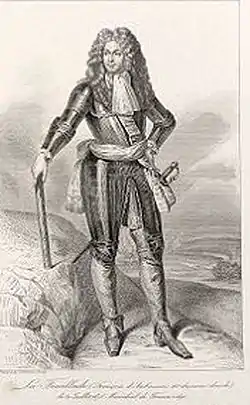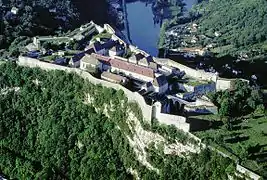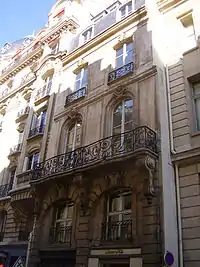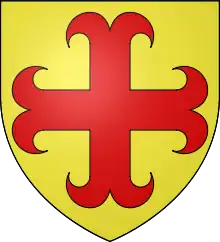François d'Aubusson de La Feuillade
François d'Aubusson de La Feuillade, known as 6th duc de Roannais (1631–1691) was a French military officer and noble who served in the wars of Louis XIV and became a Marshal of France. He was also responsible for initiating the design and construction of the Place des Victoires, one of modern Paris' most famous landmarks.
François d'Aubusson, Comte de La Feuillade, Vicomte d'Aubusson, Marquis de Boisy, Baron de la Borne, leur-dit 6th duc de Roannais aka duc de La Feuillade | |
|---|---|
 François III d'Aubusson, duc de Roannais (1631–1691) | |
| Born | 21 April 1631 Courpalay, Île-de-France |
| Died | 19 September 1691 (aged 60) Paris |
| Buried | Saint-Eustache Cemetery, Paris |
| Allegiance | |
| Service/ | Army |
| Years of service | 1649–1691 |
| Rank | Marshal of France 1675 |
| Unit | Gardes Francaises, 1672 – 1691 |
| Battles/wars | Fronde 1648–1653 Franco-Spanish War, 1635–1659 Arras 1654 Valenciennes 1656 Austro-Turkish War Saint Gotthard 1664 War of Devolution Franco-Dutch War 1672–1678 Siege of Besançon (1674) |
| Awards | Order of the Holy Spirit 1688 |
| Other work | Governor of the Dauphiné 1681–1691 |
Early life
François d'Aubusson de La Feuillade was born on 21 April 1631 at Courpalay in the Île-de-France near Paris, fifth and last son of François II, Comte de La Feuillade (ca 1590 to 1632) and Isabeau Brachet de Pérusse.[1] The d'Aubussons were a prominent and well connected family; Pierre d'Aubusson (1423–1503), was Grand Master of the Knights Hospitaller Order and his elder brother Antoine was an advisor to both Charles VII and Louis XI.
François' father, the Comte de La Feuillade and his eldest brother Leon (? to 1648) were senior aides to Gaston, Duke of Orléans (1608–1660), heir to the French throne until the birth of Louis XIV in 1638. He had three other brothers, Georges (1609–1697), who later became Bishop of Metz, Gabriel-Bratchet (? to 1638) and Paul (1622–1646). Of his five sisters, Elizabeth (1624–1704) became Abbess of Sainte-Marie de la Règle in 1679 but little is known of the others, who all appear to have become nuns.[2]
In April 1667, Artus de Gouffier (1627–1696), 5th duke of Roannais assigned his titles and property to La Feuillade in return for 400,000 livres and marrying his sister, Charlotte de Gouffier (? – 1683).[3] Artus legally remained 'duke' during his lifetime and so François was known as 'leur-dit 6th duke of Roannais' or sometimes 'duke of La Feuillade.' He and Charlotte had three children before her death in 1683; Louis-Joseph-George (1670–1680), Marie-Theresa (1671–1692) and Louis d'Aubusson de La Feuillade (1673–1725).
Career
.jpg.webp)
The first half of the 17th century in France was a period of intense civil strife; the 1590 Edict of Nantes ended the French Wars of Religion but continued state persecution caused a series of Huguenot rebellions in the 1620s. This was followed by the 1635–1659 Franco-Spanish War, accompanied by a struggle for power during the minority of Louis XIV that led to the 1648–1653 civil wars known as the Fronde. Their impact can be seen in the history of de La Feuillade's immediate family; his father was killed in 1632 at Castelnaudary and three of his brothers died in battle, Leon at Lens in 1648, Gabriel-Brachet at Saint-Omer in 1638 and Paul at Mardyck in 1646.[4]
He began his military career in 1649, as captain in a regiment commanded by the Duke of Orléans; during the 1650–1653 Fronde des nobles, he and his brother Georges de La Feuillade backed the Court party led by Louis XIV's mother, Anne of Austria and Cardinal Mazarin. He was wounded at the Royalist victory of Rethel in December 1650; the Battle of the Faubourg St Antoine in July 1652 ended the Fronde as a serious military threat, although some like Condé changed sides and fought on with the Spanish.[5]

The Spanish had taken advantage of the Fronde to recover some of the territory lost after their defeat at Rocroi in 1643 and the Franco-Spanish War now resumed. La Feuillade participated in a number of actions, including Arras in 1654; he was wounded and captured at Valenciennes in 1656, a Spanish victory inflicted on the French by Condé.[6]
When the war ended with the 1659 Treaty of the Pyrenees, La Feuillade was Governor of Crozet, near the modern Swiss border. He joined the French contingent under Jean de Coligny sent by Louis to support Austria in the 1663–1664 Austro-Turkish War and fought in the August 1664 victory of Saint Gotthard.[7]
In April 1667, Artus de Gouffier (1627–1696), 5th duke of Roannais assigned his titles and property to La Feuillade in return for the payment of 400,000 livres, as well as marrying his sister and heir, Charlotte de Gouffier (? – 1683). Artus de Goufier was a Jansenist, like his close friend writer, mathematician and Catholic theologian Blaise Pascal, who entered a monastery after renouncing his titles. During his lifetime, François was officially known as 'leur-dit 6th duke of Roannais' or 'duke of La Feuillade;' it was not until Artus's death in 1696 that his son Louis d'Aubusson finally became 'Duke of Roannais.'[8]
During the 1667–1668 War of Devolution with Spain, La Feuillade was in the army under de Rochebaron that captured the towns of Bergues, Veurne and Courtrai/Kortrijk between June and July.[9] When it ended, he was part of a French expeditionary force sent to the Venetian island of Candia or Crete, besieged by the Ottomans since 1648 but it was withdrawn in August 1669 and the island surrendered in September.[10]

Appointed Colonel of the Gardes Francaises when the Franco-Dutch War began in 1672, he fought in the Netherlands and various other theatres, including Franche-Comté in 1674, when he led an assault during the Siege of Besançon and took Salins-les-Bains on 22 June.[11] He was rewarded by being made Marshal of France in 1675 and military Governor of Dole, regional capital of Franche-Comté until it moved to Besançon in 1676.[12]
In January 1678 he replaced Vivonne as Viceroy in Messina, Sicily. France had supported the 1674 Messina revolt against their Spanish rulers but by the end of 1677, the pressure on French resources meant Louis decided to withdraw. De La Feuillade was proclaimed the new viceroy with great pomp on 28 February 1678; in reality, he was there to evacuate French troops, which was completed on 13 March.[13] On returning to France, he took these troops to Roussillon, in support of the siege of Puigcerdà.[14]
The 1678-1679 Treaties of Nijmegen ended the Franco-Dutch War and De La Feuillade's military career, although he retained his position as Colonel of the Gardes Francaises. After the death of the duc de Lesdiguières in May 1681, he was appointed Governor of the Dauphiné but apart from this, the rest of his life was devoted to the building of the Place des Victoires. The square was the centre piece of an ambitious building project, including the construction of private residences, among them his own town house, the Hôtel de La Feuillade; he was ruined by the enormous cost, estimated at over seven million livres and the building work was not completed until after his death in 1696.[15]
He died on 19 September 1691 and was buried at Saint-Eustache, one of the cemeteries whose contents were later transferred to the Catacombs of Paris in 1787.[16]
Legacy


To celebrate the end of the Franco-Dutch War, La Feuillade funded the design and construction of the Place des Victoires, which was completed in 1686 by Jules Hardouin-Mansart, Superintendent of Royal Buildings, responsible for Les Invalides and the Place Vendôme. The centre of the square contained a statue of Louis XIV trampling the Triple Alliance, with a much smaller one of La Feuillade himself elsewhere; both were destroyed in 1792 during the French Revolution, the current monument being a replacement installed in 1828.[18]
He also resurrected a scheme originally proposed by the 15th century merchant Jacques Cœur to make the River Loire navigable from Roanne to its exit point into the Atlantic Ocean) at Saint-Nazaire. Until the advent of railways, goods and supplies were largely transported by water; the scheme would enhance the economy of Roanne, which had been damaged by the expulsion of the Huguenots following the 1685 Edict of Fontainebleau and towns along the route and provide an alternative to export routes along the Scheldt then dominated by the Dutch.
In his Mémoires written in the 1720s, Saint-Simon (1675–1755) dismisses François as someone who gained their status through flattery and subservience.[19] The accuracy of this is hard to assess; Saint-Simon was 16 when François died in 1691 and uniformly hostile to Louis XIV and his supporters, the majority of whom he dismissed as commoners.[20]
References
- Homs, George J. "François III d'Aubusson, duc de La Feuillade". Geni.com. Retrieved 15 December 2018.
- Anselme, Augustin Dechauffé, Du Forny (1750). Histoire de la Maison Royale de France, et des grands officiers de la Couronne Volume V. Compagnie des Libraires. p. 349.
- Anselme, & Du Forny p.349
- Anselme & Du Forny, p. 347
- Tucker, Spencer C (2009). A Global Chronology of Conflict: From the Ancient World to the Modern Middle East 6V: A Global Chronology of Conflict [6 volumes]. ABC-CLIO. p. 654. ISBN 978-1851096671.
- Black, Jeremy (2009). The Cambridge Illustrated Atlas of Warfare: Renaissance to Revolution; Volume 2. Cambridge University Press. p. 77. ISBN 978-0521470339.
- De Bouhours, Pere (1806). Histoire de P. d'Aubusson-La-Feuillade, Grand Maître de Rhodes (4th ed.). La Compagnie de Jesus. p. 303.
- Anselme, & Du Forny p. 349
- Moreri, Louis (1749). Le grand dictionnaire historique ou Le melange curieux de l'Histoire sacrée; Volume I. Libraires Associes, Paris. p. 496. Retrieved 22 December 2018.
andre joseph d'aubusson.
- "De La Feuillade, Francois d'Aubusson". Tombes et sepultures. Retrieved 21 December 2018.
- De Périni, Hardÿ (1896). Batailles françaises, Volume V. Ernest Flammarion, Paris. p. 63.
- Woolley, Richard, Besongne, Nicolas (1687). The present state of France. Gilbert Cownely, London. p. 420.
- Nolan, Cathal (2009). Wars of the Age of Louis XIV, 1650–1715: An Encyclopedia of Global Warfare and Civilization. Greenwood. pp. 289–290. ISBN 978-0313330469.
- De Périni, Hardÿ p. 215
- "Place des Victories". Sortir a Paris. Retrieved 22 December 2018.
- Philippe Lefrançois, Paris souterrain, coll. Encyclopédie pittoresque, Les Éditions internationales, 1950, p.59.
- Popoff, Michel, Pinoteau, Hervé (1996). Armorial de l'ordre du Saint-Esprit. Le Léopard d'or. p. 204. ISBN 2-86377-140-X.
- Dubois, Isabelle, Gady, Alexandre (2003). Place des Victoires: Histoire, architecture, société. Maison des Sciences de l'Homme. pp. 67 passim. ISBN 978-2735110032.
- Saint Simon, duc de, Louis (1720–1721). Saint-Simon. Mémoires (1711–1714). Additions au Journal de Dangeau (1988 ed.). Editions Gallimard. p. 678.
- Fallon, Brian (20 November 1999). "Review of Duc de Saint-Simon: Memoirs, Vol.1: 1691–1709 edited and translated by Lucy Norton". The Irish Times. Retrieved 20 December 2018.
Sources
- Anselme, Augustin Dechauffé & Du Forny; Histoire de la Maison Royale de France, et des grands officiers de la Couronne, Volume V; (Compagnie des Libraires, 1750);
- Black, Jeremy; The Cambridge Illustrated Atlas of Warfare: Renaissance to Revolution; Volume 2; (Cambridge University Press, 2009);
- De Bouhours, Pere; Histoire de P. d'Aubusson-La-Feuillade, Grand Maître de Rhodes;' (La Compagnie de Jesus, 1677; 4th edition 1806);
- Dubois, Isabelle, Gady, Alexandre; Place des Victoires: Histoire, architecture, société; (Maison des Sciences de l'Homme, 2009);
- Moreri, Louis; Le grand dictionnaire historique ou Le melange curieux de l'Histoire sacrée; Volume I; (Libraires Associes, 1749);
- Nolan, Cathal; Wars of the Age of Louis XIV, 1650–1715: An Encyclopedia of Global Warfare and Civilization; (Greenwood, 2009);
- Saint Simon, duc de, Louis; Saint-Simon. Mémoires (1711–1714); Additions au Journal de Dangeau; (Editions Gallimard);
- Tucker, Spencer C; A Global Chronology of Conflict: From the Ancient World to the Modern Middle East: A Global Chronology of Conflict in 6 volumes; (ABC-CLIO, 2009);
External links
- Fallon, Brian (20 November 1999). "Review of Duc de Saint-Simon: Memoirs, Vol.1: 1691–1709 edited and translated by Lucy Norton". The Irish Times. Retrieved 20 December 2018.;
- "Place des Victories". Sortir a Paris. Retrieved 22 December 2018.;
- "De La Feuillade, Francois d'Aubusson". Tombes et sepultures. Retrieved 21 December 2018.;
- Homs, George J. "François III d'Aubusson, duc de La Feuillade". Geni.com. Retrieved 15 December 2018.
| Military offices | ||
|---|---|---|
| Preceded by Antoine de Gramont |
Colonel of the Gardes Francaises 1672–1691 |
Succeeded by Louis-François de Boufflers |
| Preceded by François Emmanuel de Créquy de Bonne, 4th duc de Lesdiguières |
Governor of La Dauphiné 1681–1691 |
Succeeded by Louis d'Aubusson de La Feuillade |
| French nobility | ||
| Preceded by Artus de Gouffier |
leur-dit 6th duke of Roannais 1667–1691 |
Succeeded by Louis d'Aubusson de La Feuillade |
| Preceded by Leon d'Aubusson de La Feuillade |
Comte de la Feuillade 1648–1691 |
Succeeded by Louis d'Aubusson de La Feuillade |